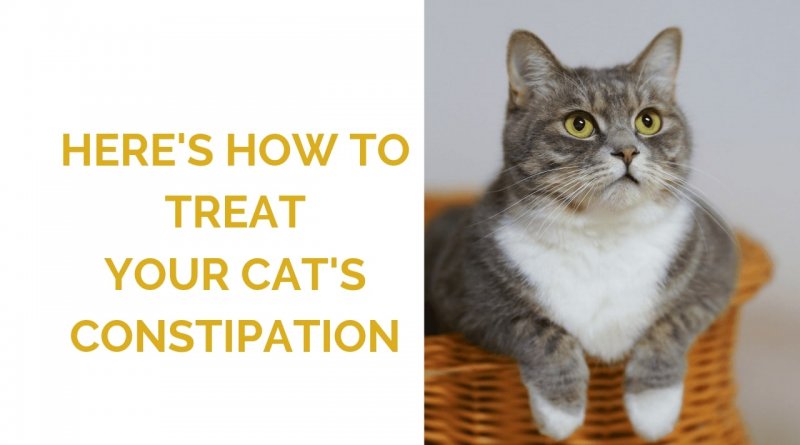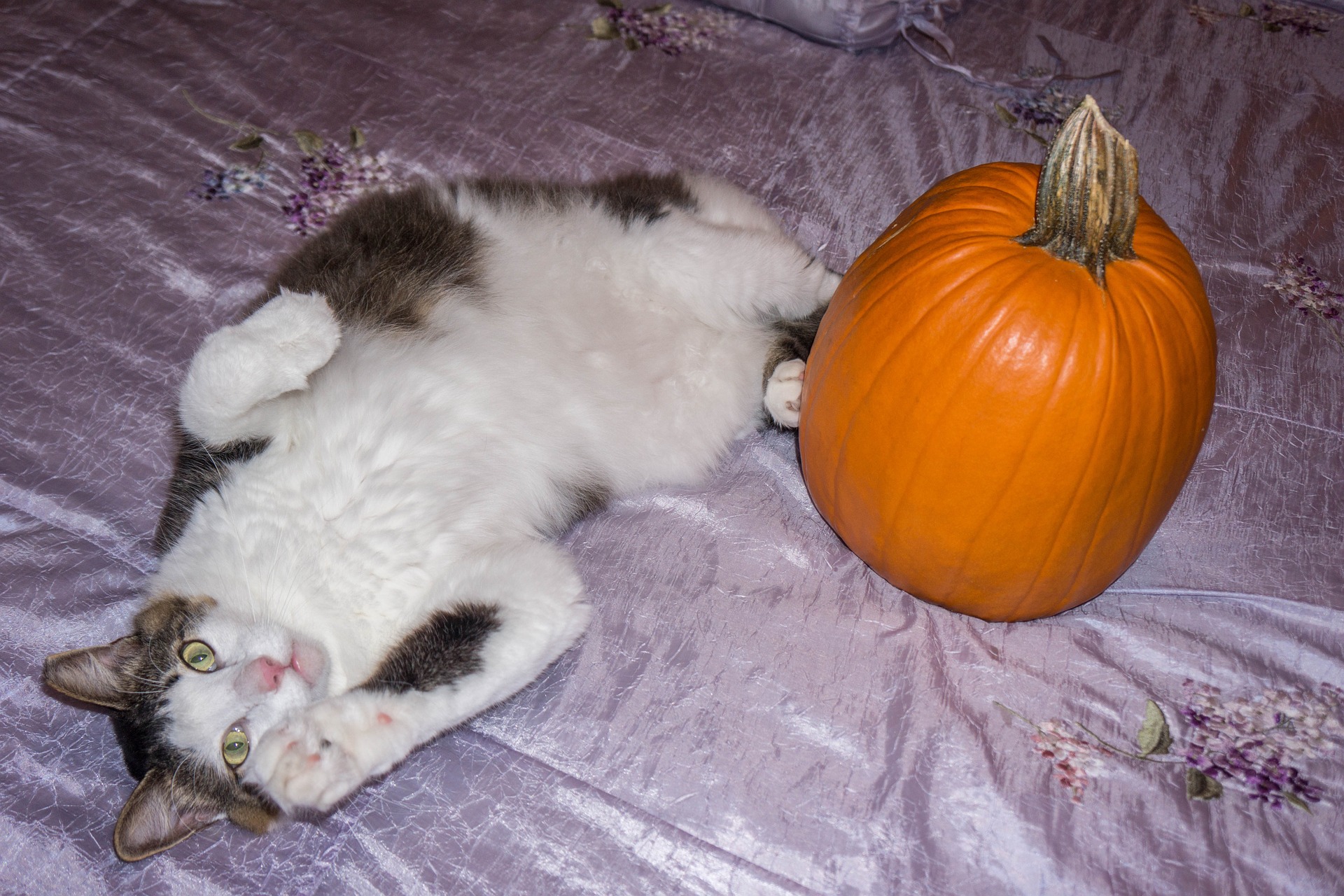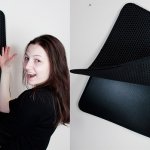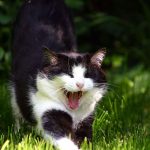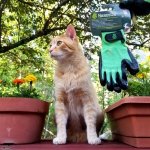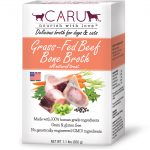Cat Constipation Treatment: Remedies, Food, and When to See the Vet
Last Updated on
In this guide to cat constipation treatment, you’ll learn about the symptoms of constipation, which food to choose, how to treat constipation at home, and when to bring your cat to the vet.
Quick Navigation
First…what is constipation?
Constipation is a word we use to say that emptying the bowels is harder than usual.
Let’s take a trip inside of your cat’s body to get a closer look at how constipation develops.
Starting at your cat’s mouth and ending at his anus is a dynamic waste processing plant called the digestive system.
Every time your cat eats, the digestive tract receives the food, breaks it down, sends the valuable parts into the body, turns what’s left into feces, and, normally, tells the rest of the body when it’s time to squeeze it out.
Constipation is most often the result of problems within the second-to-last stop before the litter box—a roughly 15-inch segment called the large intestine. The large intestine includes the colon, which is responsible for drawing water out of the stool and turning it from sludge to fudge. In non-constipated cats, the process goes perfectly and you get a smooth, sausage-style log.
If the stool doesn’t spend enough time in the large intestine, it won’t have a chance to firm up. That’s diarrhea.
If it stays there too long and loses too much water, you’ll have hard, dry balls of feces or perhaps stool that’s so firm and dry that it can’t get out of the body at all.
This is the problem at the heart of most cases of constipation.
What causes constipation in cats?
Constipation isn’t a disease or condition of its own. It’s a symptom of other problems in the body. Let’s talk about some of the most common causes of cat constipation. Note that most cases of constipation are idiopathic, meaning that a veterinarian isn’t able to identify its root cause.
Dehydration
When a cat’s body dips below the normal 65% to 75% water content, it tries to restore normal fluid levels by concentrating urine (often leading to crystals and blockages) or drinking more. If that’s not enough, water is reabsorbed from the colon, letting the stool go dry.
Your cat may become dehydrated after losing water due to increased urination associated with kidney disease or diabetes or after they’ve been vomiting and having diarrhea. Constipation may result from low water intake.
Jean Hofve, DVM, said in her article on feline constipation that “In more than 18 years of experience as a feline veterinarian, I have not personally seen constipation problems in cats who do not eat dry food.”
And though some cats eat high-moisture wet and raw food and still get constipated, it definitely appears that cats who eat dry food are more likely to develop this problem.
Remember that dry food is literally deficient in an essential nutrient—water. Because of their naturally low thirst drive, every few cats ever drink enough to compensate for that deficiency. Even if your cat does drink a lot, that won’t reverse the dehydrating effects of a dry diet. In fact, cats who eat a dry diet consume an estimated 50% of the total water taken in by a cat on a wet diet.
Inadequate Dietary Fiber
As I mentioned in our article on the truth about raw cat food and constipation, raw-fed cats are at an increased risk of constipation. These diets tend to be very “clean” and don’t have much indigestible matter, also known as fiber.
The popular image of fiber shows it as this sort of bulking agent that plumps the stool, just making it more voluminous and puffy and soft, helping it to move through the body. This is more or less an accurate image when we’re talking about insoluble fiber. Soluble fiber absorbs water and is more fermentable than insoluble fiber.
Note that almost all fiber sources are some mix of soluble and insoluble fiber, so a single fiber source may have multiple functions in the body, including bulking the stool and feeding beneficial bacteria in the gut.
Fiber isn’t metabolizable. Instead of turning into glucose like other carbohydrates, it either passes out of the body or ferments in the gut. What’s actually happening when we say that something is “fermented” is that it’s digested by bacteria instead of your cat. When bacteria eat fiber, the gut fills up with, essentially, bacteria poop. The by-products of bacterial digestion include short-chain fatty acids (SCFAs). These SCFAs maintain a slightly acidic fecal pH, which helps it to retain water. More water retention means it’s softer, bigger, and more likely to come out.
So fiber aids in the fight against constipation in multiple ways—not only by providing bulk, but also by feeding the beneficial gut bacteria that keep the digestive system healthy.
Though feline fiber requirements aren’t fully understood right now, it appears that cats naturally ferment a fiber analogue—indigestible animal matter. One study on big cats (digestively almost identical to your cat) found that indeed, they did ferment the indigestible animal matter, like hair, skin, claws, and connective tissue.

These indigestible tissues are exactly what you’re avoiding when you choose by-product-free food. Most people omit them when they’re making a fresh or raw cat food. If you’re making your cat’s food and not substituting for these indigestible tissues, you’re not really making a whole prey diet. If your cat is constipated on this type of food, inadequate fiber is most likely the culprit.
If you can’t include carnivore-appropriate fiber, what can you do? At this point, the best option is to incorporate a little plant-sourced fiber into your cat’s diet. You have about a gazillion options for fiber supplementation. We’ll get into those later.
What if your cat already eats a high-fiber diet and is constipated anyway?
Don’t get the wrong idea about fiber—it’s not a cure for constipation and it’s not a dose-to-effect medication. If your cat’s diet is full of fiber (in other words, if it’s anything like the average kibble, especially the kind of food that’s marketed for cats who live indoors or have hairballs), there’s no need to add even more fiber! In fact, some experts are now recommending that constipated cats eat a low residue diet instead of high-fiber food.
Low Food Volume
Defecation is, in part, triggered by the feeling of fullness. If your cat eats a very calorie-dense, low-volume diet (think Ziwi Peak air-dried food), they may not have the feeling of fullness and colonic stretching experienced by a cat on a high-volume diet. Additionally, cats who nibble at their food throughout the day may never get that nice big Thanksgiving dinner stretch, which some suggest plays a critical role in telling the body it’s time to evacuate.
Inadequate Activity
Sedentary cats are more prone to constipation because they don’t jump, jiggle, run, and generally stimulate their bellies through exercise. The rhythmic motions of exercise help to stimulate the contractions of the intestine (also known as peristalsis) which push waste towards the rectum.
Holding It In
Let’s say that every time your cat walks towards the litter box, he’s ambushed by your German Shepherd. Realizing that the litter box isn’t a safe place to go, your cat has no choice to hold it in and wait for a safer moment. By the time Scarfy is out taking his evening bathroom break, your cat no longer has the urge. The longer stool hangs out in your cat’s colon, the drier it becomes and the harder it will be to pass it next time.
A dirty litter box, a scary or noisy litter box location, and even the pain of constipation itself can lead to litter box avoidance.
Physical Obstruction
Occasionally, cats develop constipation due to a physical obstruction in the digestive tract. This may involve a stricture (narrowing) in the colon due to something pressing against it or a foreign body that’s made its way into the colon and blocked it off.
Constipation as a Result of Other Conditions
Constipation is sometimes connected to other health conditions, including inflammatory bowel disease or cancer. General dehydration or muscle weakness caused by kidney disease or diabetes may also lead to constipation.
If your cat is on any medications, including opiates, anticholinergics, and sucralfate, they could contribute to constipation.
An estimated 60% of feline constipation cases are idiopathic, meaning that the cause is unknown.
Just as most humans vaguely attribute their constipation to “not enough fiber” but don’t give it much more thought, most constipated cats don’t receive a clear diagnosis. Knowing exactly why your cat is constipated would narrow down your treatment options, but most guardians don’t get that luxury.
How do you know your cat is constipated? Symptoms of cat constipation include:
- Straining in the litter box. Remember that urinary tract disease is sometimes mistaken for constipation. The two conditions share a common symptom—mewing and straining in the box. Before you assume that your cat is constipated, make sure your cat is still urinating normally.
- Small, pebble-like stools. Like humans, cats should produce smooth, slightly cracked sausages. Their stool shouldn’t come out looking like malted milk balls.
- Not pooping at all or infrequent defecation. Just like humans, cats should go number two every day, sometimes twice a day. If your cat is only going once every other day or once every four days or even more, he’s constipated.
- Only letting out tiny squirts of liquid stool. Constipation can cause inflammation in the colon, leading to diarrhea.
- In severe cases, constipated cats may have a reduced appetite and lower energy levels.
- Some constipated cats vomit because they feel too full or because they’ve been straining too hard.
Once you’ve seen these symptoms, you can assess the status of your cat’s constipation by palpating his abdomen.
This video shows you how to palpate your cat for constipation. When your cat is lying down, approach from above and slowly slide your hands up your cat’s sides, feeling for the tubular structure under the spine. In healthy cats, this will feel like a nickel-to-quarter sized tube. You may also feel soft pieces of stool. If your cat has megacolon or severe constipation, you’ll feel a big plum-sized tube and it will be firm. In some cases, the colon may be painful and your cat will yelp when you palpate.
How do you know if you need to bring your constipated cat to the veterinarian?
It can be difficult to recognize when your cat’s constipation is something more serious. The line between a minor tummy issue and a life-threatening condition is more blurry than you might expect.
Some hints that it might be a good idea to see the vet for your cat’s constipation:
- Your cat hasn’t defecated in four days or more.
- Your cat shows other signs of illness or appears to be in pain,
- You’ve palpated your cat’s colon and it feels full and stretched.
- If your cat’s constipated due to a physical obstruction, he definitely needs treatment from a veterinarian, but this can be difficult to determine at home.
Even after medical treatment, your cat may be diagnosed with obstipation, which is just a term vets use to describe a type of constipation that’s not responsive to medical treatment. It’s saying “this is really bad constipation”.
If your cat’s colon remains full of dry feces for too long or if constipation recurs too many times, he may develop megacolon. Megacolon may occur on its own or as a result of recurrent or sustained constipation. In megacolon due to constipation, your cat’s colon gets stretched and strained to the point that it’s no longer able to contract and push the poop out on its own.
If your cat has megacolon, your vet will want to make sure that your cat’s stool stays as soft as possible. Since the smooth muscle of the colon is no longer working on its own, your vet will probably recommend that you put your cat on a steady regimen of medications that stimulate colonic contraction.
Before these maintenance measures, the vet will rehydrate your cat and then perform an enema or manual extraction. Finally, if your cat doesn’t respond to treatment and continues to have episodes of constipation, your vet may choose to remove most of the colon. The surgery is usually successful, with most cats having a few weeks of diarrhea afterward and then going back to normal.
Can cats die of constipation?
It’s certainly possible that a cat could die from constipation. People have died from constipation due to bowel perforation or heart arrhythmias associated with intense straining and, in one horrible story, a man died of a heart attack after inhaling liquid feces that he’d vomited due to severe untreated constipation. All of these possibilities apply to cats just as they do to humans, with the possible exception of straining too hard.
That said, it’s difficult to find documentation of feline death by constipation. In most cases, if a constipated cat dies, they haven’t died from constipation. They died of whatever connected illness led to or exacerbated the constipation.
Cat Constipation Treatment at Home: Steps to Take
In most cases, you can treat your constipated cat at home using a combination of home remedies, dietary changes, and increased activity. If you’ve determined that your cat doesn’t need immediate veterinary care, take the following steps to treat your constipated cat at home.
1. If your cat is on a dry diet, switch him to a high-moisture diet as soon as you can.
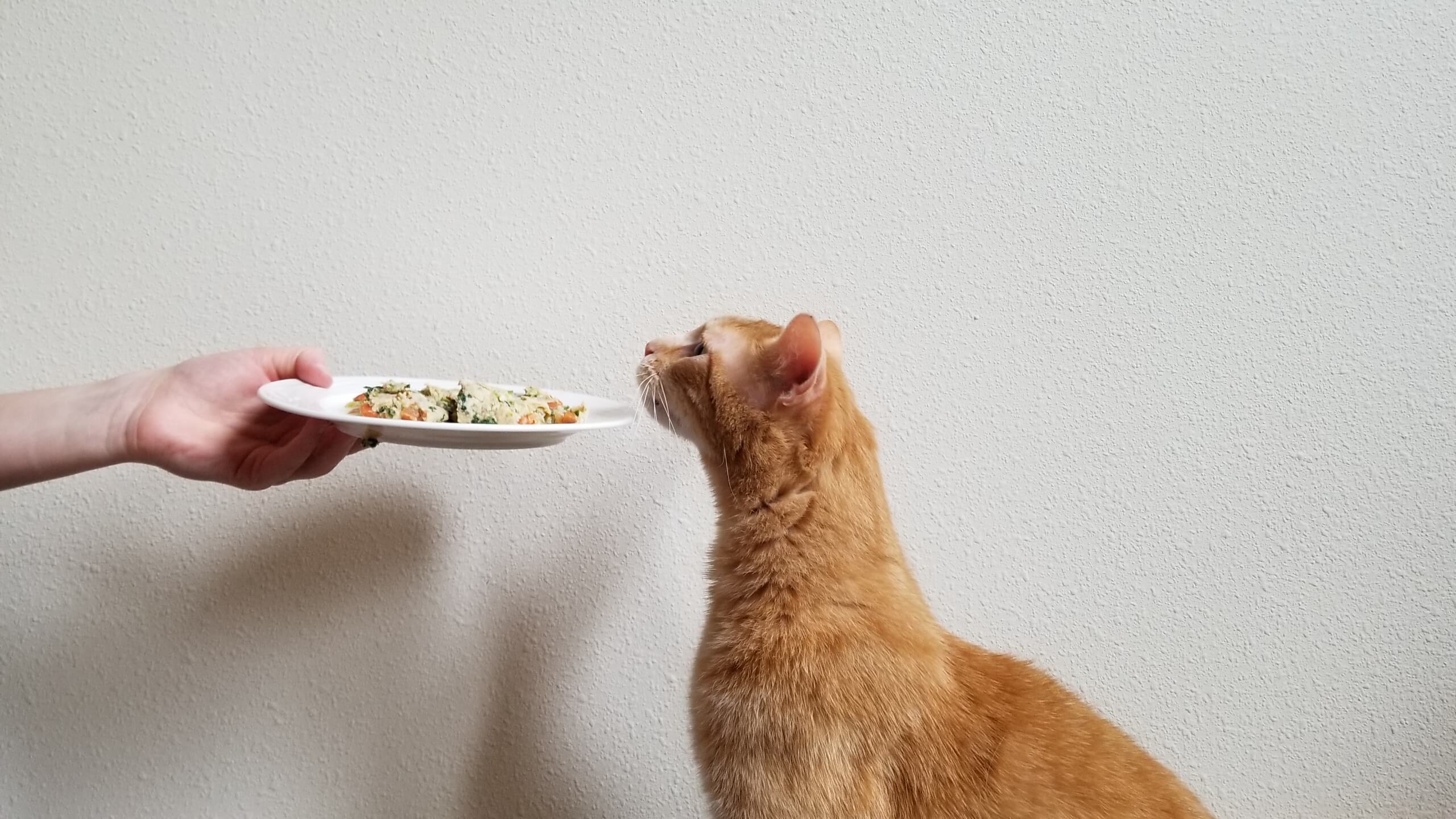
Rule out acute dehydration by pinching your cat’s scruff. If the skin goes down slowly or doesn’t descend into a normal position at all, your cat is seriously dehydrated and requires emergency fluid therapy. If you’re able to administer subcutaneous fluids at home, great. Otherwise, bring your cat to the vet.
Once you’ve established that your cat is not severely dehydrated, you still want to increase the amount of fluid circulating in his body.
The best way to accomplish this is by switching from a dry diet to a food that’s inherently rich in water. Instead of struggling with tuna juice in the water bowl and buying a water fountain and trying to get your cat to use it, just give them more water in their food. It’s how cats work naturally and it’s a heck of a lot easier. Plus you’ll probably lower your cat’s carbohydrate intake while you’re at it, which is a good way to spare him and yourself the giant frustration that is diabetes.
It’s a win-win-win situation on multiple levels.
Tips for Transitioning Your Cat From Dry to Wet Cat Food
If you’re having a hard time transitioning your cat from one food to another, there are a few things you can do to quickly increase your cat’s water intake.
One is to start mixing warm water at a 1:1 ratio into your cat’s dry food. Remember that this makes the food a breeding ground for bacteria and aflatoxins, so be sure to refrigerate or toss it after a couple of hours.
The second is to make it a gentle transition, gradually incorporating the wet food into your cat’s usual kibble.
Third, you can apply enticements to your cat’s food. Bonito flakes, dried liver powder, cooked flaked chicken, tuna juice, Purina FortiFlora, and crushed Temptations treats are all highly-effective toppers that can convince most cats to take a nibble.
Finally, don’t give up! Most, if not all, cats can make this transition. If cats were not flexible enough to consume what was available to them, they would have died out as a species. As grim as it sounds, hunger will eventually overrule taste and your cat will have to try the new food.
But make sure you’re making this as easy as possible. Think about your cat’s preferences and honor them. I find one of the best sources of inspiration is your cat’s dinnertime begging habits. If your cat ever begs for and eats people food at the dinner table, which foods seem to be his favorite? You can get some great hints from this. For example, our cat Wessie goes berserk over freshly cooked chicken—roast chicken, chicken strips, morsels of cleaned chicken from inside a chicken pot pie—he loves it. It’s no surprise that he’s also madly in love with NomNomNow’s Chicken Chow Meow food, which is a pouch full of fresh, human-grade flaked chicken. It’s like getting “people food” for every meal, except it’s a nutritionally complete diet.
So listen to your cat! He can try new things. You just have to know how to identify his desires and find where they intersect with yours.
2. Try administering cat-appropriate laxatives.
Both before and after you switch your cat onto a high-moisture diet (if necessary), try giving him laxatives. These stimulate the colon into action, helping to encourage the passage of stool.
Cat Constipation Home Remedy Type 1: Laxatives
- Cat Lax is a feline laxative and hairball treatment that you buy in a tube. It’s primarily made of cod liver oil with petrolatum, plus sweeteners and flavors. This product is essentially a lubricant and protectant that keeps the stool from further drying in the colon.
- Laxatone is another hairball treatment and laxative that comes in a tube. The gel contains petrolatum, mineral oil, and soybean oil as active ingredients, along with sweeteners, preservatives, and flavors. Like Cat Lax, it’s a lubricant laxative.
- Miralax is a laxative brand marketed for humans. It and its generic equivalents. are made from polyethylene glycol 3350. This ingredient is osmotic, which increases the water retention of the stool, making it easier to pass. Give your cat ⅛ to ¼ teaspoon once daily until your cat’s symptoms resolve. Because it draws water into the stool, Miralax could cause constipation if your cat isn’t drinking enough.
- Butter, coconut oil, and olive oil all work in essentially the same way. They’re sources of fat and, compared to animal fat, aren’t very easily digested, so they may hasten things on their way out of the body. While olive oil is frequently recommended, it’s not a good choice for cats. It contains terpenes and phenols, which could build up in your cat’s liver. Give your cat ½ to 1 tablespoon mixed into your cat’s food.
- Raw liver and animal fat are the most carnivore-appropriate of the laxatives on this list. Their laxative effect is mild, but can shorten transit time and encourage your cat to go—plus most cats enjoy eating them.
3. If your cat is on a wet, raw, or another low-fiber diet, add in some fiber.
If your cat’s diet is already 7% or more fiber on a dry matter basis (common among hairball control foods, weight loss foods, and those marketed for indoor cats) there’s probably no need to add more fiber. If, however, your cat is eating a low-fiber diet, fiber supplementation could help.
Most wet foods fall into this category, as do raw, freeze-dried, and fresh foods. Because most recipes don’t account for the indigestible portion of the whole prey, homemade raw food is often very low in fiber and sometimes doesn’t have any fiber at all.
Cat Constipation Home Remedy Type 2: Fiber
- Pumpkin pureé is the most commonly prescribed home remedy for cat constipation. Though it’s often described as “very high in fiber”, fiber is definitely not the quality that makes pumpkin helpful for constipation. Pumpkin purée has less than 1 gram of fiber per ounce and is one of the least concentrated sources of fiber you can give your cat. Nevertheless, many cats do very well on pumpkin and we can only think that it must have some other anti-constipatory effect in the GI tract. Give your cat ½ to 1 teaspoon of pumpkin purée per day.
- Psyllium husks are a source of soluble fiber and the primary ingredient in Metamucil and Fiberall. You can find it veterinary brands at a pet food store or, for the best deal, buy it in bulk from a natural food store. Mix ¼ to a ½ teaspoon of powdered psyllium husk to your canned cat food.
- Chia seeds have 10 grams of fiber per ounce. They’re primarily a source of insoluble fiber.
- Ground flaxseeds are seeds with about 8 grams of fiber per ounce, leaning towards soluble rather than insoluble fiber. They’re safe for cats and easy to mix into your cat’s food.
- Guar gum is a common ingredient in canned cat food that’s both a source of soluble fiber and known for its laxative properties. You can either give it to your cat by finding food that contains guar gum or by mixing guar gum into it.
- Powdered cellulose, also known as wood pulp, is 100% insoluble fiber. It’s commonly added to food products as a filler and fiber additive.
- Cat grass is the cat’s fiber additive of choice. The name “cat grass” refers to several varieties of grasses, including oat grass, barley grass, and rye grass. Cat grass is easy to obtain and grow at home.
- Slippery Elm is a fiber source that’s highly mucilaginous and can soothe digestive discomfort. For the best price and easiest administration, look for slippery elm bark powder in the bulk department at a health food store. Give your cat ¼ teaspoon per 10 lbs of bodyweight. The powder should be mixed with cold water or cooked into a syrup. You can learn more about how to prepare slippery elm for cats here.
4. Encourage your cat to exercise.
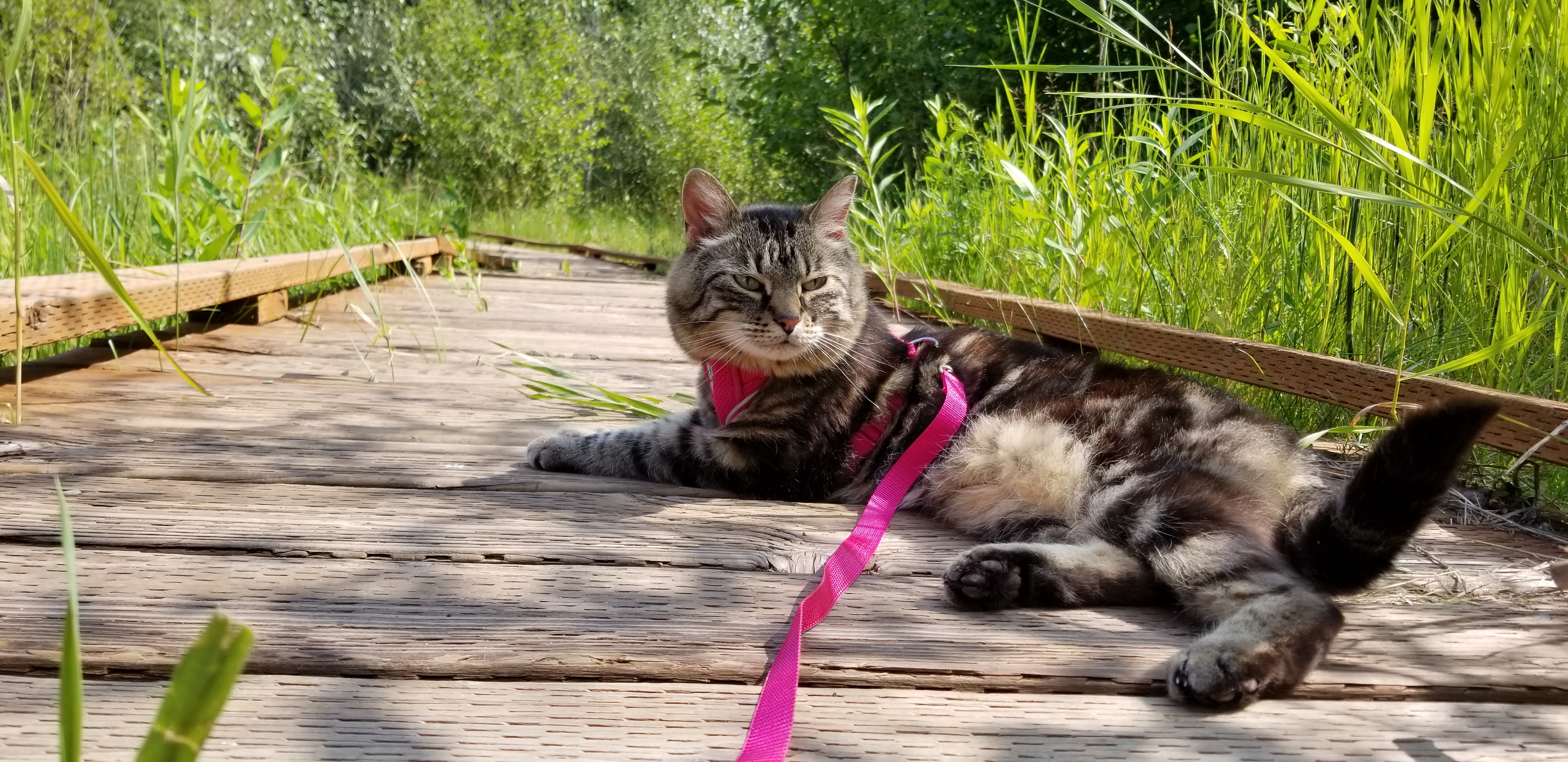
Exercise addresses your cat’s constipation in multiple ways. The first is by stimulating peristalsis—the rhythmic contractions of your cat’s intestine. The second is by helping your cat to lose weight. Overweight cats are much more likely to become constipated, so it’s essential that you help your cat reach a healthy weight. Third, exercise relieves stress, which is sometimes responsible for feline constipation.
Your cat’s exercise routine can be as unique as your cat is. Try 15 minutes of predatory play or a supervised walk outside.
5. Consider giving your cat an enema or suppository at home.
It’s best to administer this treatment under the guidance of your veterinarian.
- One option is a warm (body temperature) water enema. The goal of a warm water enema is not to dissolve the stool, but to plump up the rectal area just enough to tell the digestive system it’s time to go. This can be good if your cat’s constipation is relatively mild, but if there’s a huge amount of rock hard poop in the colon, the addition of water to that mass will only make things more painful. This is just one reason why it’s best to consult your veterinarian before you administer an enema. If you choose to give your cat a warm water enema, you can administer either 100% water, or, for better results, a 50-50 mix of water and a water-based lubricant like plain K-Y jelly. K-Y jelly contains glycerin, which makes the whole situation a little bit more slippery and easier to pass. In total, your enema should add up to less than 10 ml or about two teaspoons. If you make your own enema, you’ll have to pair it with an enema syringe or bulb.
- If you’d rather use something that’s made specifically for cats, try a Feline Pet-ema. These cat enemas are available without a prescription. Each tube contains 6 ml of dioctyl sodium sulfosuccinate in glycerin, a mix that softens feces and stimulates the intestinal mucosa.
- Pediatric glycerin suppositories are easy to find, affordable, and often effective for cats. The box contains everything you need and it’s relatively easy to administer. You’ll have the most success if you can recruit another person to hold your cat while you administer the suppository.
- You can also dip the end of a Q-tip in liquid glycerin, gently insert the Q-tip into your cat’s rectum, then repeat this several times. This will help to stimulate your cat’s voiding reflex and help to draw some water into the colon.
Do NOT use a phosphate or saline enema! These enemas are totally unsafe for cats. As little as 60ml could cause vomiting, severe electrolyte abnormalities, diarrhea, and more—including death.
Can massage help cat constipation?
Maybe, but frankly, massage doesn’t appear to be the best way to resolve your cat’s constipation. If you do want to massage your cat, be extremely gentle and read up on feline anatomy to make sure you’re not pressing on the wrong spots. Remember that your cat’s colon is usually most accessible by running your hands along the spinal area, not the underside of the belly. Don’t try to squeeze out the poop like it’s a sausage from a casing.
If you like massaging your cat, try bringing a brush into your massage sessions. Excessive hair ingestion is associated with constipation, so removing some excess hair will make your petting sessions more effective.
What’s the best cat food for constipation?
When choosing food for your constipation-prone cat, you should first establish a basic understanding of feline dietary needs.
These baseline needs will thin out your options, leaving you with a roster of excellent candidates, only a few of which will stand out as particularly well-suited to constipation. Qualities to look for in a food for constipated cats include high moisture content (essential for all cats), fiber, and perhaps probiotics.
Ultimately, it’s better to give your cat an outstanding food with no constipation-specific qualities than to give your cat a prescription food for constipation. You can always mix in extra fiber, but you can’t get artificial colors out.
A few foods that we recommend for constipated cats:
Nulo Freestyle Turkey & Chicken Recipe – This canned food contains probiotics, which help to promote a healthy digestive system and may support good stool consistency. It contains guar gum and agar-agar as binders, both of which are sources of soluble fiber and can help to reduce constipation. It also contains a trace of pumpkin.
NomNomNow Chicken Chow-Meow – This fresh, homemade-style food isn’t particularly high in fiber, but it is a high-moisture product that’s extremely palatable, species-appropriate, and, thanks to NomNomNow’s personalized portions, could help your cat lose weight. NomNomNow can be pretty expensive, so you’ll want to take advantage of the 50% discount NomNomNow is offering our readers.
Weruva Cats in the Kitchen Funk In The Trunk Chicken in Pumpkin Consomme – This canned Weruva food is a hit with constipated cats, guys. Just take a look at the customer reviews and you’re sure to see a few people talking about their cats finally letting loose something funky from their trunk after eating this food. It’s primarily made from fresh chicken and tuna in a juicy consommé. It contains pureéd pumpkin, along with three different thickeners. These include locust bean gum, guar gum, and xanthan gum.
Wellness CORE Natural Grain Free Turkey & Duck Paté – This canned food is pretty meat-rich and features pork liver as the second ingredient. Remember that liver is a mild laxative. The food also contains a couple of fibrous ingredients that could help solve your cat’s constipation. The food contains ground flaxseed, a source of both insoluble and soluble fiber and it has chicory root extract, a prebiotic fiber that feeds the healthy bacteria in your cat’s gut.
Lotus Duck Paté – This food is meat-rich and hydrating with duck, duck, broth, and pork liver. Again, liver is a mild laxative. The food also contains flaxseed and agar-agar as sources of fiber. Near the end of the ingredient list is a little bit of olive oil, which could also act as a laxative. Because this food contains quite a few plant ingredients, it’s not our first choice for most cats, but it could be a helpful choice for constipated cats.
How do you prevent cat constipation?
Once you’ve tackled and treated your cat’s first bout of constipation, how do you keep it from happening again? Most of the treatments that help to relieve constipation can be continued in the long-term to prevent a recurrence.
Keep your cat on a high-moisture diet.
To keep all of the cells in your cat’s body plump and well-hydrated, continue to feed him a diet that is rich in moisture. Note that I didn’t recommend a high-fiber diet. Increasing your cat’s fiber intake may be a good choice for some cats, but it’s not necessarily the best long-term strategy. Considering that a low-residue diet is also sometimes recommended for constipation, fiber isn’t necessarily the answer. Instead, experiment with various fiber levels and incorporate probiotics to create a healthy gut ecosystem.
If your cat’s overweight, help him to reach a healthy weight.
Compared to slim cats, overweight kitties are definitely more likely to develop constipation. Continue to encourage your cat to exercise regularly and feed controlled portions of carnivore-appropriate food.
Brush your cat regularly.
For some cats, hairball prevention is synonymous with constipation prevention. What’s better than a regimen of hairball diets and petroleum jelly? A regular grooming routine. Capture loose hair before it jams up in your cat’s GI tract by swiping it away on a brush. Not sure how to choose the right brush? Check out our guide to the best cat brushes.
NOTE: While this may work for some cats, it may be the completely wrong approach for others. Some have suggested that hair ingested from grooming is a form of indigestible animal tissue and serves as a species-appropriate source of fermentable matter, aiding in the digestive process and preventing constipation.
Make sure the litter box is in a safe, comfortable location and clean it regularly.
If you determine that your cat’s constipation was caused by litter box avoidance, identify the problems in your old litter situation and resolve them. Make sure the litter box is in a quiet, safe place where your cat won’t be disturbed by people, dogs, or other cats.
Cat Constipation Treatment: Summary
Feline constipation is not a condition of its own—instead, it’s a symptom of problems affecting the digestive tract. Causes range from physical obstruction to dehydration to an overly clean diet. Severe constipation demands a trip to the veterinarian, where your vet can rehydrate your cat, administer an enema or manual fecal removal, and prescribe long-term treatments.
Mild constipation can be treated at home through a combination of hydration, gentle laxatives, and fiber. In some cases, you may need to administer a home enema or suppository.
Treating your cat’s constipation involves trial-and-error. You may have to try multiple remedies or several remedies at once before you find something that works for your cat. Implementing healthy habits reduce or eliminate the likelihood of recurrence in most cats, but not all. Some cats have irreparable damage to the smooth muscles of the colon and, unless they undergo surgery to remove part of the colon, will be on drugs and laxatives for the rest of their lives.

